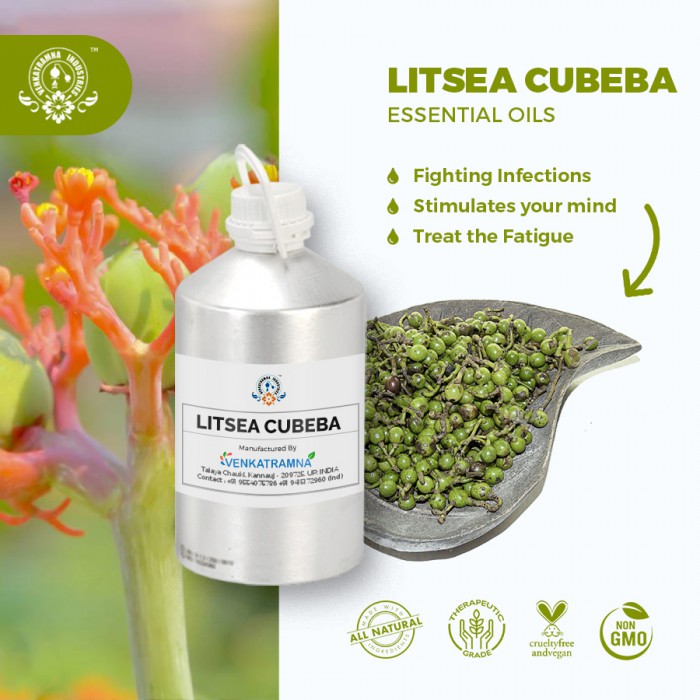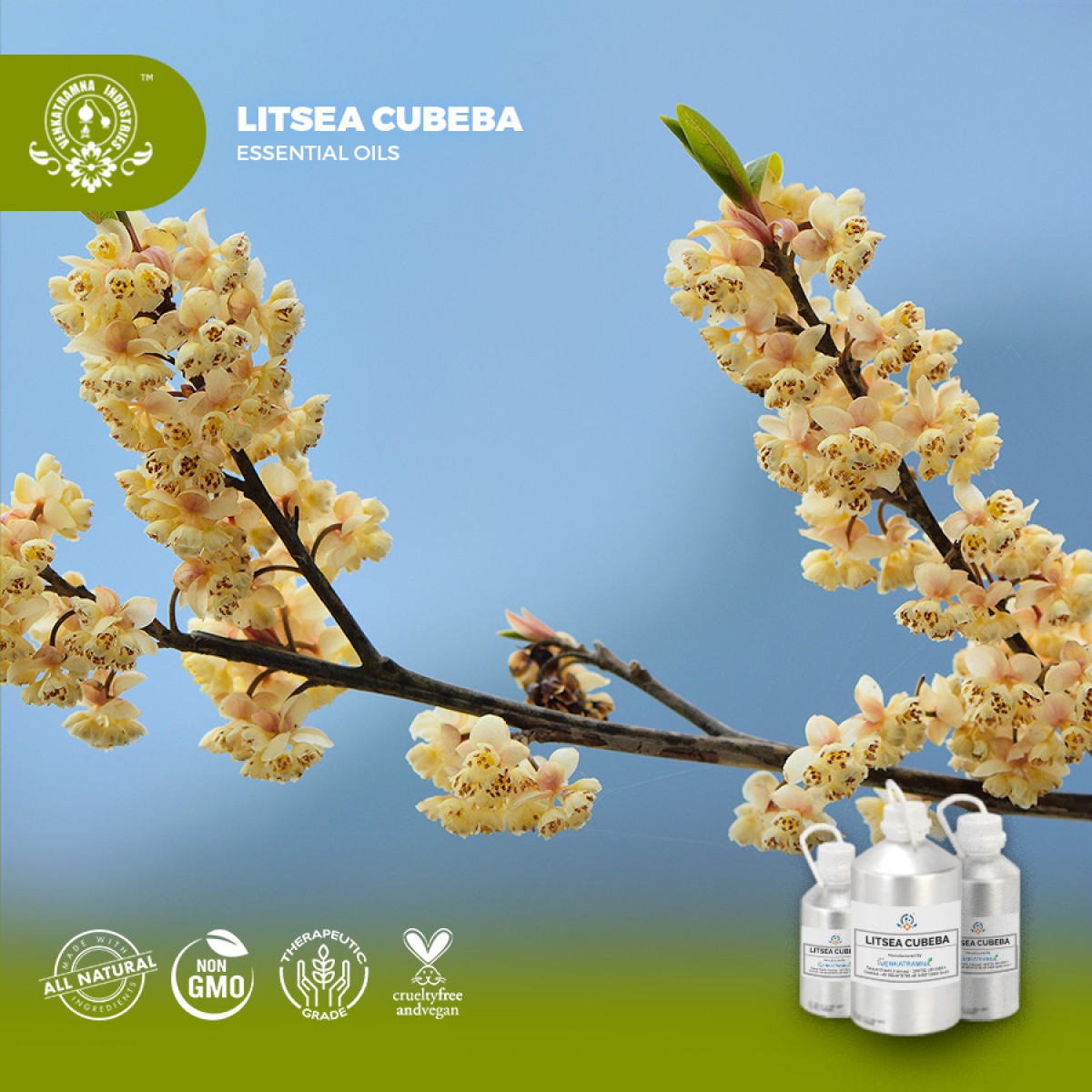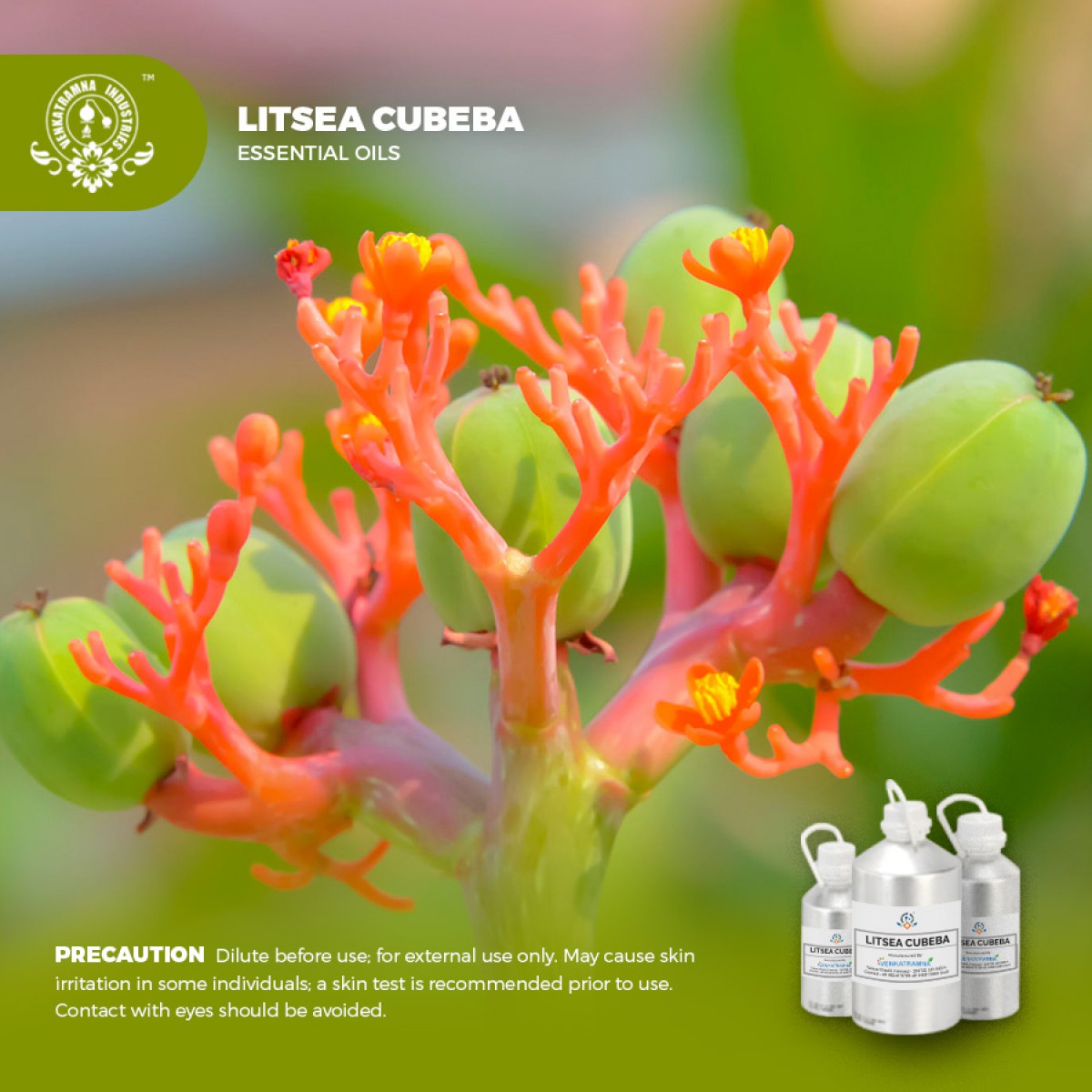Botanical Name: Litsea Cubeba Common name: Aromatic litsea, May chang Read More
|
Botanical Name: |
Litsea
Cubeba |
|
Common name: |
Aromatic litsea, May chang |
|
Plant
family: |
Lauraceae |
|
Genus: |
Litsea |
|
Appearance/Color: |
Pale yellow to yellow liquid with thin and clear consistency |
|
Odor: |
It has
a crisp, citrus smell with medium aroma at a top note |
|
Blends With: |
Basil, Bay, Black pepper, Cardamom, Cedarwood, Chamomile, Clary
sage, Coriander, Cypress, Eucalyptus, Frankincense, Geranium, Ginger,
Grapefruit, Juniper, Marjoram, Orange, Palmarosa, Patchouli, Petitgrain,
Rosemary, Sandalwood, Tea Tree, Thyme, Vetiver, Ylang-Ylang. |
|
Origin: |
China |
|
Source: |
Fruits |
|
Method
of Extraction: |
Steam
Distillation |
The genus Litsea is predominant
in tropical and subtropical regions of India, China, Taiwan, and Japan. The
plant possesses medicinal properties and has been traditionally used for curing
various gastro-intestinal ailments (e.g., diarrhea, stomachache, indigestion,
and gastroenteritis) along with diabetes, edema, cold, arthritis, asthma, and
traumatic injury. Besides its medicinal properties, Litsea is known for its essential oil, which has
protective action against several bacteria, possesses antioxidant and
antiparasitic properties, exerts acute and genetic toxicity as well as
cytotoxicity, and can even prevent several cancers. Here we summarize the
ethnopharmacological properties, essentials oil, medicinal uses, and health
benefits of an indigenous plant of northeast India, emphasizing the profound
research to uplift the core and immense potential present in the conventional
medicine of the country. This review is intended to provide insights into the
gaps in our knowledge that need immediate focus on in-situ conservation
strategies of Litsea due to its
non-domesticated and dioecious nature, which may be the most viable approach
and intense research for the long-term benefits of society and local peoples.
Litsea Cubeba is the botanical name for May Chang, a tree belonging to the Lauraceae family. It bears whitish-yellowish flowers that have a characteristic citrusy fragrance and fruits that resemble peppers. Litsea cubeba, or ‘May Chang,’ is a tree that is native to the Southern region of China, as well as the tropical areas of Southeast Asia such as Indonesia and Taiwan, but varieties of the plant have also been found as far as Australia and South Africa. The tree is very popular in these areas and has been utilized for a variety of reasons for hundreds of years.
DISCLAIMER
The complete range of conditions
or methods of use are beyond our control therefore we do not assume any
responsibility and expressly disclaim any liability for any use of this
product. Information contained herein is believed to be true and accurate however,
all statements or suggestions are made without warranty, expressed or implied,
regarding accuracy of the information, the hazards connected with the use of
the material or the results to be obtained from the use thereof. Compliance
with all applicable federal, state, and local laws and local regulations
remains the responsibility of the user.
The FDA has not evaluated the
statements on this website. No claims are made by Venkatramna Industries as to
the medicinal value of any products from vriaroma.com or by us. The information
presented here is for educating our customers about the traditional uses of
essential oils and is not intended to diagnose, treat, cure, or prevent any
disease. You are responsible for understanding the safe application of these products.
If you have any questions, please call or email us for further information.
As per NAHA guidelines, New Directions Aromatics
(NDA) does not recommend the ingestion of essential oils. It is imperative to
consult a medical practitioner before using Essential Oils for therapeutic
purposes. Pregnant and nursing women and those taking prescription drugs are
especially advised not to use this product without the medical advice of a
physician. The oil should always be stored in an area that is inaccessible to
children, especially those under the age of 7.
Litsea cubeba is a pioneer herb traditionally
utilized in medicine. Different extracts from its plant parts, such as bark,
leaf, root, and fruits, have been utilized in traditional Chinese medicines for
curing various diseases. The fresh green fruit is used for culinary purposes
like salad preparation, chutneys, pickles,
Litsea cubeba encompasses a varied number of
structurally diverse biologically active compounds, and their uses in
traditional medicines and their various functions. The major groups of
compounds include alkaloids, monoterpenes, sesquiterpenes, diterpenes,
flavonoids, amides, lignans, steroids, and fatty acids. These compounds have
anticancer, anti-inflammatory, antimicrobial, antioxidant, antidiabetic, and
anti-HIV properties, and therefore have immense potential for treating various
diseases
Litsea Cubebe produces odor active compounds while the
fruits contain biologically active components that are utilized in various
foods as a source of natural ingredients and for flavor.
COMMON
USAGE
·
Fighting
Infections
·
Stimulates
your mind
·
Treat
the Fatigue
·
Good
for Skin and Personal Care
·
Combat
Athlete’s Foot
·
Treats
pain and inflammation
·
Asthma
·
Cures
problems with digestion
·
Backache
·
Muscles
Pain
·
Arrhythmia
·
Regulate
Blood Pressure
·
Pampers
your skin health
·
Kills
insects and keeps your home fresh and clean
·
Allergic
·
Bronchitis
·
Treat
the Nausea
·
Headache
Ingredients:
|
S.No |
Key Constituents |
Strength (%) |
|
1 |
Geranial |
37.9–40.6 |
|
2 |
Neral |
25.5–33.8 |
|
3 |
(þ)-Limonene |
8.4–22.6 |
|
4 |
Methyl heptenone |
0.5–4.4 |
|
5 |
b-Myrcene |
0.5–3.0 |
|
6 |
Linalool |
1.2–1.7 |
|
7 |
Geraniol |
0.5–1.6 |
|
8 |
Sabinene |
0.1–1.6 |
|
9 |
Linalyl acetate |
0–1.6 |
|
10 |
a-Pinene |
0.8–1.4 |
|
11 |
b-Pinene |
0.4–1.2 |
|
12 |
Nerol |
0.2–1.1 |
Safety Summary
·
Hazards:
Drug interaction; teratogenicity; skin allergy.
·
Cautions (all routes): Drugs metabolized by CYP2B6.
Cautions (oral): Diabetes medication, pregnancy.
·
Cautions (dermal): Hypersensitive, diseased or damaged skin,
children under 2 years of age. Maximum daily oral dose in pregnancy 56 mg
Maximum
dermal use level 0.8%
·
Safety advice
Recommended
maximum dermal use of 0.8% to avoid skin sensitization. This is based on the IFRA
maximum for citral of 0.6% for body oils and lotions and 75% citral content. We
recommend a daily oral maximum in pregnancy of 56 mg. This is based on 74%
citral content, with dermal and oral citral limits of 0.6% and 0.6 mg/kg.
Organ Specific Effects
·
Adverse skin reaction:
Undiluted
May Chang oil was moderately to markedly irritating to rabbits and was strongly
irritating to both mice and pigs; tested at 8% on 25 volunteers it was neither
irritating nor sensitizing. It is non-phototoxic. In a study of 200 consecutive
dermatitis patients, three were sensitive to 2% May Chang oil on patch testing.
Citral can induce sensitization reactions, and this effect can allegedly be
reduced by the co-presence of (þ)-limonene. In a mouse local lymph node assay,
which allows comparative measuring of skin sensitizing potency, May Chang oil
was a weak sensitizer, with a similar potency to citral.
·
Cardiovascular effects: Gavage doses of 10, 15 or 20 mg/kg/ day
citral for 28 days, dose-dependently lowered plasma insulin levels and
increased glucose tolerance in obese rats.
·
Reproductive toxicity: Citral is dose-dependently teratogenic
because it inhibits retinoic acid synthesis, and this can affect fetal
development.
Systemic
Effects
·
Acute
Toxicity: May Chang oil
acute oral LD50 in rats >5 g/kg; acute dermal LD50 in rabbits 4.8 g/kg.
Tests using both rats and mice resulted in the following approximate values for
May Chang oil: acute oral LD50 4.0 g/kg, acute dermal LD50 >5.0 g/kg,
inhalation LC50 12,500 ppm.
·
Carcinogenic/anti carcinogenic potential: May Chang oil was not geno toxic to
Salmonella tymphimurium and did not induce micronuclei in bone marrow cells or
chromosome aberrations in mouse spermatocyte cells. Citral, (þ)- limonene, and
geraniol display anti carcinogenic activity
o
Acute aquatic toxicity: Not determined
o
Persistence and degradability: Not available.
o
Mobility in soil: Not available.
o
Results of PBT and vPvB assessment: Not
determined
o Do
not allow the material to enter streams, sewers or other waterways.





 MSDS-Litsea.pdf
MSDS-Litsea.pdf




